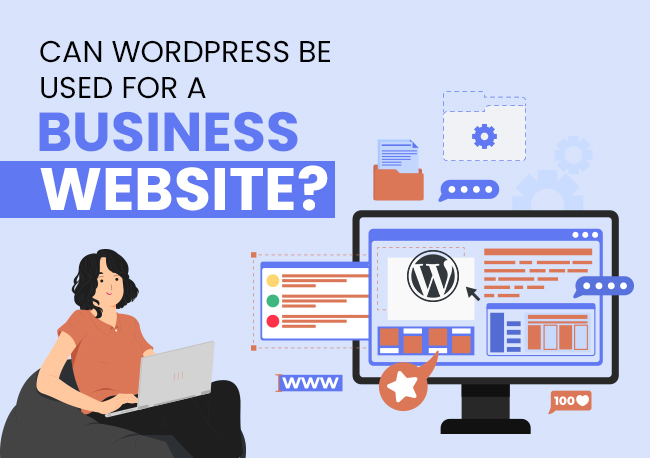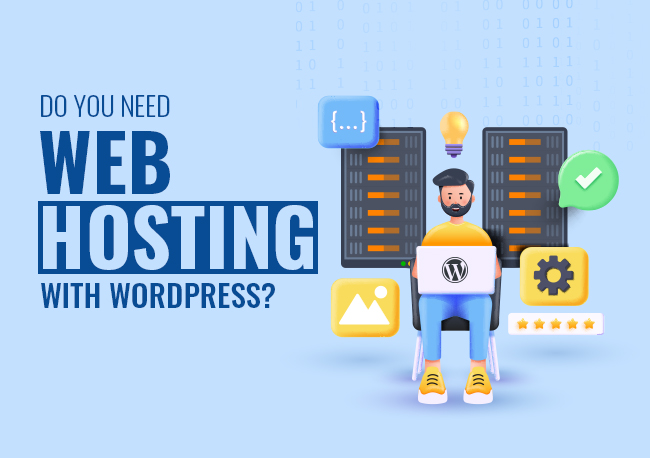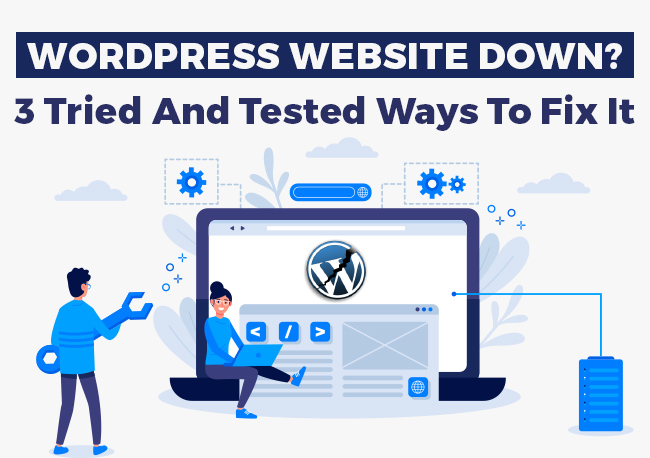| Getting your Trinity Audio player ready... |
On May 27th, 2003, a true game changer emerged in the innovation and technology industry, swiftly rising to the top and becoming one of the most popular platforms of the 21st century.
Yes, you guessed it right!
We are addressing the one and only “WordPress.”
Over the years, WordPress has paved its way into the hearts of industry experts, developers, and website owners, successfully sustaining its position as the most preferred choice of countless users. As of 2024, it acquired a remarkable 810 million users, which is estimated to be 43% of websites on the internet.
From bloggers to eCommerce entrepreneurs to non-profit organizations to creative professionals, a wide range of businesses and individuals leverage the potential of this versatile platform, thanks to its user friendly interface, vast ecosystem of themes & plugins, flexibility, and accessibility to users of all levels and backgrounds.
Amidst the prevalence, many businesses have raised their concern about whether this platform will turn out to be as impressive and successful for their venture. To find out an answer to this question, delve deep with us into this write up as we explain the benefits and steps to setting up a website on WordPress.
What is WordPress?
WordPress is a content management system (CMS) developed 20 years ago by Mike Little and Matt Mullenweg over PHP, a backend programming language. As the name suggests, this platform was introduced with the intention of uploading & managing web content and extending the freedom to customize the website according to the needs.
Since you have been introduced to the concept of WordPress, let’s look at some statistics showcasing its growth and usage over the last two decades.
- In the past 10 years, WordPress has sown its seeds of success by elevating from 17.4% in 2013 to 43.1% in 2024, becoming the fastest growing platform for ten annual cycles in a row.
- Every 2 minutes, another 10 million sites start using WordPress.
- 97% of bloggers’ first preference is WordPress.
- 69% of users utilize WordPress as the CMS for their website.
Also Read: WordPress.Com Vs WordPress.Org – What’s The Difference?
Now that you know about these staggering numbers and how WordPress rules the web. We shall walk you through the benefits of using the platform for business websites.
Benefits of Using WordPress for Business Websites

➢ User-Friendly Interface
Starting from the top, WordPress has one of the most intuitive and user-friendly interfaces, making it effortless to use, especially for budding entrepreneurs. If you have been using WordPress for a while now, you would know that its UI has significantly evolved since it launched and arguably has grown into a full fledged platform.
Initially, the admin panel allowed bloggers to write and publish blogs directly. The developers kept the features pretty simple and focused on the editor interface. In the later years, its structure was enhanced, and numerous amazing elements such as SEO-friendly URL structure, comment moderation, and a new installer were introduced.
Cut to 2024, its front and backend have everything a business owner might ask for — An appealing & straightforward layout, easier access to templates, pages, themes, patterns, styles, and navigation menus, with several improvements to the block editor section.
The current version, 6.4 Shirley, released on November 2023, surpassed the preceding iteration by making some notable changes in the managing patterns and bringing categories to the front. It also has duplicate, transform, delete, or insert command options, ensuring optimum performance.
Overall, its dashboard has listed and classified all the primary functionalities for business owners to keep an eye on the growth and manage their website content, update pages, and add new features effectively without having to deal with the technicalities.
Also Read: Website Builder Vs WordPress – Know The Difference
➢ Simple & Quick Setup
You might be wondering that setting up WordPress would be a tough nut to crack, but dear reader, let us tell you it is as easy as eating your favorite piece of cake.
The setup process is fairly undemanding — All you need to do is install the software from the ZIP file after downloading it, upload it to your hosting account, log in to your cPanel account, create a database on your server & user account, configure your data, run the program, and voila! You are all set to roll.
Now, choose a theme and tailor it to the needs of your business. Besides the home page, additional important pages such as About Us, Contact Us, and similar can also be created using a pre built layout or from scratch by selecting different elements.
Similar to other steps, designing a menu is equivalently simple. The editor option allows you to edit the navigation block and systemize the menu to fit your requirements.
Also Read: Best Content Management System Platform Optimized For SEO
➢ Low Development Costs
One of the core advantages of creating a website on WordPress is the development cost. The CMS platform is open source, making it ideal for business owners who are starting out or seeking a free alternative. Although they would have to spend on buying a domain name, hosting services, and accessing premium themes and third party plugins.
However, all these costs are relatively inexpensive compared to developing a website from scratch. On a custom website, you will have to disburse funds on developer, development life cycle, third party integration, hosting & infrastructure, designing, and maintenance.
Also Read: How To Set A Budget For Your Business Website Development
➢ Easy Access & Permission Management
Much like other features of WordPress, this one, too, offers effortless & robust user management & permission to ensure collaboration, streamline the overall operations, and secure a website and its data from malicious attacks and unauthorized users.
Another fantastic edge business owners get when employing WordPress is that it showcases a range of roles, such as administrator, editor, author, contributor, subscriber, and super admin, which enables you to assign members according to their responsibilities in the organization. This facet makes sure that each asset registered on the platform can access the attributes pertinent to their roles, contributing to security and productivity.
Also Read: A Guide To Secure WordPress Website – A Complete Checklist
➢ Agile & Responsive
Whether users are accessing your WordPress website from a tablet, a personal computer, a laptop, or a cell phone, this CMS tool can adapt seamlessly to every screen and even browser, resulting in an unparalleled user experience and a boost in SEO rankings.
While responsiveness remains an undeniably phenomenal characteristic of WordPress, the agility factor that shines through its cutting edge architecture cannot be overlooked.
From rapid turnaround times to quick updates for accommodating changes in layouts & elements, user preferences, and technological advancements, WP stands as a versatile and futuristic platform, perfect for small and possibly large scale businesses.
Also Read: Do You Need Web Hosting With WordPress?
➢ Extensive Theme Library
An engaging, well structured, and intuitive layout plays a significant role in a website as it lays the foundation for amplifying the user experience. Today, digital audiences seek an experience beyond the look and feel of a website. From typography to clear navigation to the distribution of content, web users consider every aspect before interacting with your website.
This is where WordPress acts as a visual and functional backbone for a website.
WordPress has 20,000+ themes, and over 9,000 of them are free to use from the official WordPress theme repository, which facilitates creating professional, aesthetic, quirky, and various types of layouts to resonate with the identity of your business.
Also Read: Difference Between Parent Theme & Child Theme In WordPress
➢ Ability to Customize
While WordPress offers numerous pre built templates, it simultaneously gives you the power to control and create the business website of your dreams.
You might be thinking, why customize when you can harness the existing themes?
Tailoring a website to your needs can reflect the USP and identity of your business. Additionally, it fosters brand loyalty and gives you an upper hand in staying relevant in the dynamic landscape.
You can amend the desired modifications considering the evolving demands of the market, users, and search engines by integrating new components, third party tools, and updating the content.
➢ Valuable Plugins
Whether you are searching for security plugins to add a layer of protection to your website, or SEO plugins to monitor the activity and growth of a page, or a cache plugin to eliminate unwanted cookies and hike up the speed & performance of your site, WordPress has it all!
WordPress boasts an estimate of 59,208 free and premium plugins at an affordable value, which can be accessed from the WordPress Plugin Directory, says WordPress. This allows for elevating the functionality of your website further, making it premier to the standard expected by users, search engines, and the industry.
Also Read: 22 Best Plugins For WordPress
➢ SEO-Friendly Nature
Your sustenance and progress in the digital realm are firmly knotted with SEO, and fortunately, WordPress’s powerful framework has an SEO friendly nature, which can be utilized to your advantage by implementing the right SEO practices.
WP supports creating & editing permalinks, drafting meta descriptions & titles, merging social media campaigns, structuring, publishing, and updating rich content on a frequent basis, and including keywords.
Additionally, it has a range of impressive SEO compatible themes and plugins, including Yoast SEO, Google Analytics, Google XML Site Maps, and many more, empowering you to dominate the SERPs. Further, its environment is specially designed to function on a variety of web platforms without a glitch.
Also Read: Difference Between On-Page And Off-Page SEO?
➢ Active Community Support
The free, open source, and convenient-to-use form of WordPress is loved by many. In fact, numerous developers and industry experts have created communities to extend support with their valuable insights, meaningful sources, and practical solutions to queries posted by concerned individuals.
One may not only unveil tried and tested outcomes but also receive a quick response because the community is teeming with informed professionals who actively assist you at every stage.
➢ Multilingual Support
Businesses planning to expand their venture globally will find WordPress an invaluable sword in their arsenal, as plugins such as WPML offer multilingual capabilities that allow for catering and promoting their services to diverse audiences.
This tool can translate posts, custom types, taxonomies, and menus, followed by deciphering the texts used in themes. On top of that, this plugin encourages visibility on search engines across various regions and fosters cross cultural communication and meaningful connections, building credibility and trust.
Apart from this, multilingual abilities enable business owners to gain valuable insights into user behavior and track website performance through analytics tools. With this data, they create and revamp overseas scaling strategies for fruitful outcomes.
➢ eCommerce Integration
Retailers, manufacturers, wholesalers, fashion labels, artists, and service providers will hold the cards to success by integrating eCommerce plugins into their business websites.
Plugins like WooCommerce, Easy Digital Downloads, BigCommerce, MemberPress, Shopping Cart, and eCommerce Store by WP EasyCart, and similar, ease up the management of a digital business.
It can contribute to overall revenue by generating profitability and cultivating trust, as customers can reach out to you around the clock for shopping and resolving their queries, unlike the brick-and-mortar stores where accessibility is limited to working hours.
Further, you get to tap into different regions without any geographical restrictions. Additionally, payment processing and inventory management become more efficient, secure, and seamless.
Also Read: Is WordPress A Viable Option For eCommerce?
➢ Simple Maintenance
So far, we have explored numerous pros of WordPress, but the one that always steals the limelight is simple maintenance. Unlike custom websites, where maintenance relies on manually updating and creating backups, WP simplifies the upkeep journey by offering automated update and backup solutions.
Whether it’s downloading the latest release of a plugin or upgrading the core software, theme, and functionality, WordPress saves time, effort, and money, augmenting proficiency with minimal to no technical expertise.
Additionally, its rich plugin sphere has numerous tools for security scans, measuring performance, and storing backups to ensure your website functions without encountering any unwanted hurdles.
Even if you end up facing an obstacle, WordPress’s thriving community will help you dodge the bullet and carry forward your online venture efficiently.
Also Read: Ways To Backup A WordPress Website Without A Plugin
➢ Scalability For Growing Businesses
No matter if you are at the inception of your startup or broadening your entrepreneurial horizons, scalability is a cornerstone of any online business to sustain and flourish in a terrain bustling with a variety of industry players.
Crediting to WordPress, website owners can catch up with the ever evolving needs of customers & the market and, at the same time, handle the surging traffic without coming across downtime or performance issues.
By investing in this reliable platform, you also unlock the door to a higher ROI. It encourages resource utilization with no over provisioning, permitting you to up or down size the scope of your business, which also significantly cuts down unnecessary expenses.
Now that you are familiar with the perks of WordPress for a business website, let’s walk you through the practical steps of bringing your vision to life.
Also Read: The Complete Pre-Launch WordPress Website Checklist
Steps to Setup a Business Website on WordPress
- Step 1: Buy a Domain Name
- Step 2: Web Hosting
- Step 3: Download & Install
- Step 4: Theme
- Step 5: Customization
- Step 6: Create Essential Pages
- Step 7: Install Plugins
- Step 8: Configure Permalinks
- Step 9: Setup Navigation Menus
- Step 10: Implement Security Measures
- Step 11: Implement the Best SEO Practices
- Step 12: Launch Your Website
➢ Step 1: Buy a Domain Name
Stage one of building any website is buying a domain name. For readers strange with the concept of domain, it is basically the digital name of your business, which helps users discover and ingrain your brand in their memory.
If you have an existing offline business, it is suggested using the same name for consistency across all levels. In case you are taking the first step in the virtual world, select a domain name that goes side by side with your venture.
Also Read: Top 13 Techniques To Find Creative Domain Names For Your Business.
Since domain name has a substantial impact on your business –
- Ensure to choose a name that’s easy to remember, type, & pronounce and serves as the ideal symbol, demonstrating the identity and purpose of your business.
- Avoid jargon words, symbols, or numbers.
- Keep it concise and unique with keywords to improve ranking on SERPs.
- Trademark it legally to evade legal issues and potential disputes in the foreseeable future.
- Consider the long term viability of your project before picking out the name.

➢ Step 2: Web Hosting
The next course of action is web hosting, where you secure a space over the internet and store the invaluable data on the server allocated by the hosting provider.
When choosing a hosting service –
- Comprehend your needs, including the traffic, storage required for a website, bandwidth, and technicalities.
- Look for 99% or higher uptime to make your website accessible to users without a snag.
- Go for a provider that guarantees agile performance and reliable infrastructure.
- Prioritize security features such as firewalls, SSL certificates, malware scanning, website backup, and DDoS protection to avoid falling prey to cyber attacks and breaches.
- Seek a flexible plan that can easily suffice to the requirements of your online enterprise and the fluctuations in traffic.
- Consider a provider that offers 24*7 customer support.
- Select the one with an intuitive control panel.
- Read the reviews of other clients before making a decision, and compare the hosting plans with the benefits offered by the potential providers.

➢ Step 3: Download & Install
Commence to a path of triumph in the virtual realm by downloading and installing WordPress on your hosting account. This step is pivotal in creating a digital footprint of your business. If you are contemplating how to setup and tailor WordPress, scroll above to the “benefits of using WordPress,” where we have provided a comprehensive explanation of the process.
When downloading and installing WordPress, make sure to heed the following aspects –
- Download the WP from the official website (wordpress.org/download/)
- Make sure your hosting plan meets the WordPress criteria.
- Your domain name should be registered and set to link with WP.
- Backup the data from existing website, if any, to migrate it to the new server.
- Don’t forget to create a new database before installation
- Establish the necessary file permissions and update the default settings, such as username and password, to prevent security concerns.
- Remember to upgrade your website, plugins, themes, and third party resources upon the new release.
- Optimize the site with relevant SEO plugins.
- Create an access hierarchy and assign the roles within the WP dashboard.
Also Read: How To Install WordPress On VPS Hosting?
➢ Step 4: Theme
The subsequent stride in creating a business website on WordPress is designing the layout to add character to your digital venture and offer a memorable user experience that will leave them coming back for more.
- Figure out a theme that goes hand in hand with your professional goals, targeted demographics, and specific website requirements.
- Ensure the theme adapts to all screen sizes and browsers.
- Read reviews and feedback from previous users to gauge the quality, reliability, and support level before choosing one.
- Get a flexible template to customize it as you want.
- Assess the compatibility of your theme with major plugins like Elemantor, Beaver Build, Yoast SEO, and many more.
- Take customer support services into account to troubleshoot the issues instantly.
- Choose a light and well coded theme for swift performance across all devices and browsers.
- Single out themes from developers who are dedicated to long term updates and provide constant support.
- It is recommended to use a theme that complies with legal requirements and has no licensing issues.
- Test its performance and accessibility utilizing Google PageSpeed Insights and GTmetrix.
Also Read: How To Fix A Slow Website?
➢ Step 5: Customization
Bring out the touch of creativity and personalization with the next step — Customization. From drawing out a professional yet captivating template to selecting a readable & distinctive font style to framing the layout & utilizing other design elements, WordPress offers a range of customization options to carve out a peculiar and visually striking look that is as terrific and unique as your business.
Before tailoring your website, pay attention to these factors –
- Be consistent with the design, color, fonts, and imagery.
- Keep an intuitive layout and concise & clear CTAs.
- Optimize your website, visuals, remove bloated code, and use cache plugins for constant response and performance on every device and browser.
- Implement standard SEO practices to prosper digitally.
- Backup files and databases.
- Follow the advanced security practices to protect your site from data loss or security breaches.
- Add valuable and quality content to your website.
- Thoroughly test your website prior to its launch.
- Ensure your website abides by the GDPR, ADA accessibility standards, and industry specific regulations.
Also Read: Do I Need Privacy Policy For My Website?
➢ Step 6: Create Essential Pages
This step empowers you to infuse vitality into your business site by drafting and adding quality, relevant, and engaging content. Alongside the narrative, WordPress allows you to incorporate captivating visuals like images, videos, infographics, advertisements, and other pages using inherent attributes like “create a new page,” “add a title,” “add an image,” and many more.
With each page, you can talk about your vision, showcase offerings, promote your portfolio, exhibit testimonials to enhance the legitimacy and trustworthiness of your business, and add a contact form, urging users to take a desired action.
Also Read: What Makes A Good Website Checklist? A Complete Guide
➢ Step 7: Install Plugins
WordPress plugins have an eminent share in making a business website versatile, flexible, secure, and highly functional without coding.
WooCommerce, Yoast SEO, WP Mail SMTP, Booking Calendar, WP Activity Log, Akismet, and Visualizer, WordPress has a myriad of plugins accommodating the needs of every business, despite its size and specialization.
Below are some aspects you must undertake to integrate a plugin into your site –
- Prioritize the requirements and functionalities you need on your website.
- Go through reviews and user feedback to choose the best.
- Ensure it is compatible with the version of WordPress, themes, and third party plugins used on your website.
- Make sure the developer of the plugin offers reliable and constant assistance for your concerns.
- Always remember that the plugin should not reduce the turnaround time or performance of your website.
- Verify that it was created with ideal coding standards and best security practices.
- Avoid bloated plugins with unwanted features and older versions.
- Don’t forget to test the plugin on your website before installing it.
➢ Step 8: Configure Permalinks
One of the crucial aspects of setting up your website is configuring permalinks, which are permanent web addresses, representing the specific content of a page on your site.
For instance, “https://www.hostitsmart.com,” which refers to the landing or home page of the website.
Optimizing your site’s URLs is vital for users to comprehend the context of a page and search engines to fetch them and rank them on top of relevant search queries.
While URLs can be easily configured on a WordPress site by simply going to settings and then Permalinks, it’s important you,
- Incorporate relevant keywords into your URLs.
- Keep it concise and simple.
- Include hyphens (-) to enhance readability.
- Avoid underscores (_) and other special characters.
- Exclude words like “and,” “or,” “but,” and “etc.”
- Maintain a default URL structure using day and name, month and name, numeric, and post name.
- Refrain from revamping the URL frequently, as it can lead to broken links, negatively impacting SEO and user experience.
- Follow a chain of command with parent and child pages.
- Test the links before optimizing them for search engines and users.
The header, footer, and sidebar are some of the elements in the navigation menu that redirect a user to an interlinked page with the intention of fulfilling a desired action, such as filling out a contact form.
Besides achieving a pre determined goal, the main purpose of creating an intuitive menu is to ease up the user journey on your website.
To setup a navigation menu, you must,
- Reduce the number of items on your website to overwhelm users.
- List prominent pages at the top and maintain a logical order, considering the typical user flow.
- Use descriptive and straightforward labels to define the context of the menu.
- Include a search option to simplify and enhance the navigation experience.
- Test the menu periodically and remove the outdated pages or add new links to stay updated.
Also Read: 7 Best WordPress Menu Plugins Making Your Website Awesome
➢ Step 10: Implement Security Measures
Securing a business website and its sensitive information from malicious attacks and unauthorized access calls for implementing security measures. Doing so ensures your website remains accessible to the targeted audience and potential leads at all times, preserves integrity, and is compliant with legal requirements.
Below are the best practices for safeguarding your WordPress business website –
- Update your credentials intermittently.
- Use strong passwords with a mix of upper & lower case, numerals, and special characters.
- Limit multiple login attempts.
- Install security plugins like malware scanning, firewall protection, file integrity monitoring, and login activity monitoring.
- Enable two factor authentication.
- Choose a reliable and robust hosting environment.
- Use HTTPS encryption using an SSL/TLS certificate.
- Backup your website every time you make the smallest of changes.
Also Read: 9 Types Of SSL Certificates – Make The Right Choice
➢ Step 11: Implement the Best SEO Practices
We cannot stress enough how imperative it is to optimize your website by leveraging the best SEO practices, as it is the only organic medium to bring your digital mark under the spotlight, reach out to potential customers, increase credibility & revenue, and sustain constant expansion.
The best SEO practices feature –
- Include user intended keywords related to your offerings.
- Optimize meta titles, descriptions, headings, subheadings, and image alt text.
- Draft top notch and relevant content targeting the pain points of your target audience and proposing solutions for them.
- Ensure the website adapts to screen sizes of tablets, phones, personal computers, laptops, and different browsers.
- Improve the speed of the WordPress website by decreasing the size of your visuals, minimizing server response time, and using caching plugins.
- Generate high quality backlinks from authorized sites.
- Integrate social proofs for user engagement and strengthen your position on SERPs.
- Keep your website updated with the current version of WordPress, its themes, and plugins.
- Shield your website using SSL encryption.
- Install and configure SEO plugins to exercise the right SEO practices.
Also Read: Top Industries That Can Benefit From SEO
➢ Step 12: Launch Your Website
The moment you have been waiting for is here — the debut of your website. While we understand that this leap of faith unveils your unique business idea to a broader audience, but before giving it a go, it is significant to trace back to the former website setup cycle and affirm whether or not everything is suited to the requirements and functioning seamlessly.
Once everything is set, launch your site and promote it on the right platforms, such as Instagram, Facebook, LinkedIn, and Pinterest. You can also collaborate with influencers, advertise your business website on blogging sites, and run advertisement campaigns to generate quick results.
Let’s have a recap of what digital marketing strategies can be helpful for travel agency with an infographic below:

To Sum Up
This was all about channeling the potential of WordPress for a business website. We hope this write up was interactive and informative, rewarding with insights into the endless benefits and capabilities of this CMS platform that stands as the perfect medium to establish a remarkable business presence over the internet and attain every goal with confidence.
So, if you are planning to set your plans for creating a website on WordPress in motion, don’t look any further and seize the opportunity today!
Frequently Asked Questions
Here is a list of some alternatives to WordPress:
➔ Shopify
➔ Wix
➔ Joomla
➔ Drupal
➔ Squarespace
➔ Magento
Yes, various Fortune 500 companies, including NGL Energy Partners, Vistra Energy, Community Health Systems, Walt Disney Company, 21st Century Fox, Target, Microsoft, and Samsung Electronics, trust and rely on WordPress for their digital businesses.
WordPress may not be a terrific option for complex or extensively bespoke websites because such demanding projects might find it an off-the-shelf solution, limiting their possibilities of innovation, vision, and aspirations.
The choice between the two completely depends on your preferences. While both of the platforms exhibit a list of dynamic functionalities, Shopify may be more suitable for eCommerce businesses, and WordPress can be a one stop solution for countless ventures.
Whether you should choose Wix or WordPress, the decision largely relies on your needs. If you are a novice in digital territory, Wix could turn out to be a fantastic choice because of its simple and convenient infrastructure. On the other hand, website owners who pursue flexibility, control, and customization can go for WordPress.




